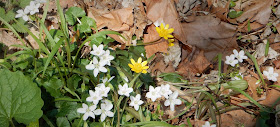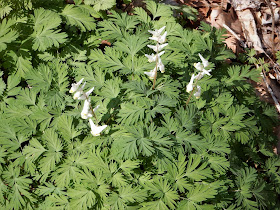Just south of the Mason Dixon Line is this little gem of a state park that tells a giant story. Palmer State Park is fairly new to the Maryland State Park system. I decided to check it out on my solo Saturday morning walk close-to-home. Everything is new - trails, parking area, signage. But the dark and white rocks I constantly tripped over told a tale of two geologic events that helped shape the landscape through which these new trails wander.
 |
| Young beech trees still cling to their fall leaves the following spring. |
Along the Pennsylvania-Maryland border just east and west of the Susquehanna River is where metavolcanic rock is visible at the surface. These rocks were formed when Supercontinent Pangaea formed 335 million years ago as plates of earth's crust collided. What is now North Africa rammed into the mid-section of North America's eastern coast, rapidly closing the Iapetus Ocean that preceded the Atlantic. A chain of volcanic islands developed ahead of the advancing North African plate and when the two continents met, the islands were trapped and crushed between them. Many of the hillsides that lead down to Deer Creek contain outcrops and scree fields of this angular igneous debris. It is dense and heavy and dark and easy to recognize as hardened magma.
 |
| A new trail crossed a magmatic rock debris field. |
 |
| Cutleaf Toothwort, an early spring eastern native. |
 |
| Walking over a volcanic island |
As I walked across the hills of volcanic rock I tried to imagine what this landscape must have looked like as, for a short time, geologically speaking, Pangaea held together for about 100 million years. The Appalachian Mountains were as high as the Alps, pushed skyward by the collision. According to fossil records, we know that the regions west of the mountains were arid and dry, while the regions here and to the east were lush and tropical. Ferns would have soared above my head. Amphibians were the size of my car and proto-crocs and alligators swam in the shallow watery basins that filled with decaying plant matter. This was the Permian - the origins of coal that would someday make Pennsylvania, West Virginia, and Western Maryland known the world over as a top producing coal region.
 |
| Dead Red Cedar and Nuthatch cache. |
This was a time when the hard or leather shelled egg became a good evolutionary idea. A few reptiles tried out feathers and wings. I noticed the hulks of dead Red Cedars now surrounded by deciduous forest. These trees reclaimed the land from farm fields in the 1940s but when this was part of the Supercontinent trees were small and ferns and clubmosses would have soared over our heads. Although Red Cedar is an ancient species that predates flowering trees, it barely would have reached my knees.
 |
| Magmatic rocks weather in blocks with angles and edges. |
 |
| Moss and lichen communities were first on the scene as magma cooled at the surface. |
After only 100 millions years, Pangaea began to was tear apart and with it went parts of the Appalachians, drifting on continental fragments across the birthing of the Atlantic Ocean. (Fragments of our mountain chain can be found in Greenland, Iceland, Scotland, Norway, Sweden, Denmark, Netherlands, England, Ireland, France, and Spain. An international extension to the famous Appalachian Trail is forming now with hiking chapters in all those regions.) As the crust tore apart, flows of molten material injected upwards from deep within the mantel to fill the gaps. This material cooled and hardened as quartz and can be found throughout the park in large veins.
 |
| Deer Creek. |
Over time, water found its way into the rifts caused by the separation of Pangaea. North of here the mighty Susquehanna makes a series of hard turn along these rift faults while in this region many of our local ravine and gorge streams like Broad Creek, Deer Creek, and Muddy Run, eroded their way through bands of hard gneiss and metaconglomerates by dissolving and following the softer quartz veins, though this process took an additional many millions of years. Under this trail massive veins of quartz come to the surface and weather out here at the surface. Easy access to tons of quartz became an important asset in the 1800s and the quartz mining industry transformed the landscape yet again.
 |
| Vine roping. |
 |
Water- smoothed magma boulders with a quartz boulder nearby.
|
The trail leads downslope across magma scree fields and into the Deer Creek valley. Never mind the huge of hunk of white quartz I tripped over down there, it's fine. Ouch. In the 1880s the Husband Flint Mill was established here to take advantage of easy access to the quartz. I came upon foundations and ruins of the mill. Large white boulders of quartz glistened in the middle of the river and the trail glistened with quartz-crumble.
 |
| Ruins of a quarry outbuilding foundation. |
 |
| One of two kilns that survives on the bank of the creek. |
 |
| Hammer room foundation at the base of the kilns. |
I climbed up on the kiln and looked into the chimney which has become a trash bin. Sad. Looking over are the ruins of flint mill. The hammer room is still clearly visible (but may not be once the leaves are fully out). Large oaken hammers were raised and dropped onto pans of "cooked" quartz and were water-powered, attached to wheels turned by creek water flowing through mill races. The hammer room crushed the brittle quartz into coarse sand that was then ground by mill stones which produced fine powders used in the porcelain and pottery factories in nearby York, Lancaster, and Baltimore. Though floods have swept away the timbers of the millstone and hammer rooms, it is still an impressive ruin. I hope the park service can do what it can ($$) to repair and preserve these ruins.
 |
| Quartz boulder in front of a sledge pile of unused shovel-sized quartz feed material for the kiln. |
About 25 men and three times as many mules provided the horse and man power to remove the quartz from the quarry pits and move it to the breaker piles where it was sledged into shovel-ready fragments carried by wagon to the kilns. There are many mule trackways that can be seen coming down from the quarries in the hills above while a large pile of unused shovel quartz sits at the intersection of the mule paths and a wagon road.
 |
| Robins were the bird of the day! |
Leaving the creek valley, the trail leads uphill to the quarries. Robins were everywhere singing their spring songs, rooting around in the leaf litter for food. One of our favorite thrushes, the males are sporting their fresh black hoods that remind me of the jackdaws in the UK, "boys in black hoods." Rooting around in the bottoms of the quarry pits seemed to be a favorite gathering place as I counted over 50 robins in one quarry and many more in a second large pit.
 |
| Large quarry pit (adorned with robins) |
My four mile loop trail ended where I started at the top of a Piedmont hill underlain with the memories of volcanic islands, a supercontinent, and a great rift that tore it all apart. In the land plans for this park, educational panels are proposed to mark important historical features and I hope geological ones as well, because without the story of the underlying geology it's just a bunch of dates and ruins. We all need context to place our stories and the robins (formerly flying lizards) would appreciate the shout-out.
 |
| Entrance to the small parking area |
* At the time I walked this trail, we were in the early stages of our great prevention intervention of social distancing to flatten the curve of the C-19 virus. It seems the advice to "take a walk" has been well heeded and many popular parks are filling up, parking may be difficult (even illegal), and some cases of vandalism and trashing have been reported. Palmer has only a small parking area and there is no parking on the narrow road which is lined with established homes and farms. Please be respectful and take care of the parks that are taking care of us during this uncertain time.
Notes:
Archaeology Report HA-1226: Husband Flint Mill
https://mht.maryland.gov/secure/medusa/PDF/Harford/HA-1226.pdf
Land Plan for the new park:
https://dnr.maryland.gov/publiclands/Documents/PalmerLandPlan2012.pdf




























